HAMPI-City with Extraordinary Architectural Importance-
|
India has a rich cultural history, and with the history comes the story and with story comes the architecture of that city.
The architecture of any city has a tale to tell us and is waiting to be heard.
Architecture is not just a structure it has a more and more to tell about itself it has its own style, secrets, lifestyle, and culture always a story to tell from where it all started.
What are the things that excite you when you hear any city? It is its food, culture or architecture. Architecture is something which marks the identity of any city.
HAMPI, KARNATAKA
A UNESCO world heritage site, Hampi was the capital of the Vijayanagara Empire. It is situated on the banks of river Tungabhadra in Karnataka. The ruins of the palaces in Hampi, the temples and the royal buildings stand testimony to the wealth and grandeur of the Vijayanagara Emperors. The name Hampi is derived from the ancient name of Tungabhadra River, Pampa, and the daughter of Lord Brahma. The town is locally known as the town of Pampa
Hampi is famous for its ruins belonging to the erstwhile medieval Hindu kingdom of Vijayanagara and it is declared a World Heritage site. The temples of Hampi, its monolithic sculptures and monuments, attract the traveller because of their excellent workmanship.
Vijayanagara Empire at its peak was very prosperous and was believed to be larger than Rome with palaces grander than of Lisbon “The city is such that the pupil of the eye has never seen a place like it, and the ear of intelligence has never been informed that there existed anything to equal it in the world”, marvelled a 15th century Persian ambassador Abdul Razaak. There were opulent palaces, marvellous temples, massive fortifications, baths, markets, aqueducts, pavilions, stables for royal elephants, and elegantly carved pillars.
You know Hampi has around 500 architectural monument (yes...! that’s too many) that makes it very special and also a must visit place.
Out of 500 I’m here sharing 10 must visits when in Hampi-
1. Virupaksha Temple
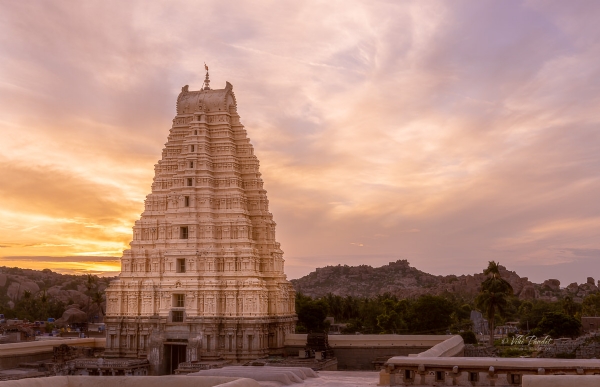
Virupaksha Temple is the oldest and principal temple in Hampi. This temple located on the south bank of the river Tungabadr. It has been an important pilgrimage centre for the worshipers of lord Shiva. The architecture of the temple is very beautiful and magnificent. There are a monastery, three antechambers and filled the surrounding of the temple with small shrines. The entrance ways surrounds with well-carved art sculptures. The gateways constructed with nine-tiered and 50 meters in length.
2. Achyuta Raya's Temple :
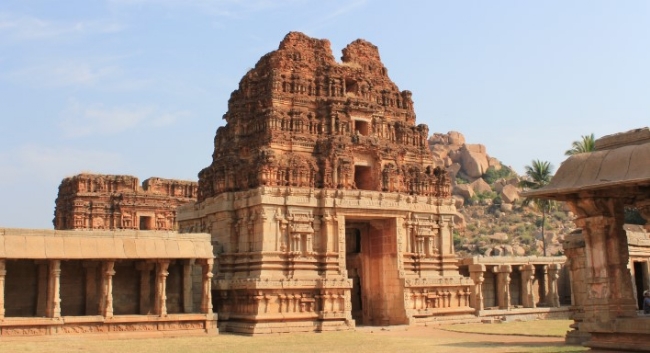
This temple is an example of Vijayanagara style temple architecture in its most advanced form than any other temples in Hampi. The temple dedicated to Lord Tiruvengalanatha, a form of Vishnu. The towers, pillars, and walls have exquisite carvings and ornamentation. Major parts of the temple are in a damaged condition. Although it is in ruins, the temple does not fail in grandiosity and its magnificence even today.
3. Sasivekalu Ganesha :
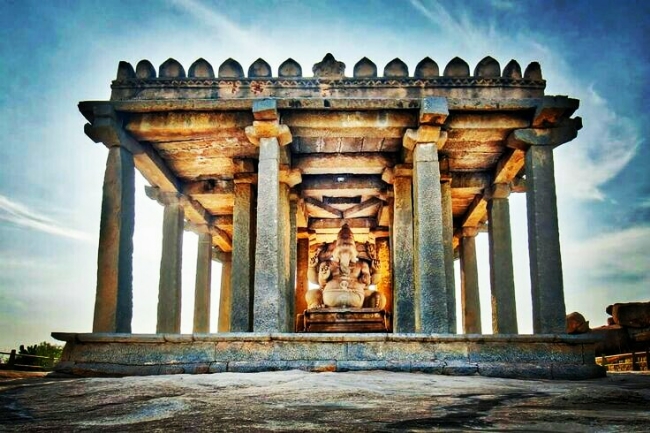
Thanks to the resemblance the giant monolithic Ganesha statue is locally called Sasivekalu (mustard seed) Ganesha. This is located on the southern foothill of the Hemakuta Hill. On this statue you can see the snake carved around his tummy. Also he holds the goad, pasha (noose), and his broken tusk. The hand which holds modak (a kind of sweet ball) is broken and not reconstructed. This monolithic statue carved out of a huge boulder measures about 2.4 meters (8 feet). An open pavilion is build around the statue. According to inscriptions found nearby this pavilion was built by a trader from Chandragiri (in present day Andhra Pradesh)in 1506 AD, in memory of one of the Vijayanagara king – Narasimha II (1491-1505 AD)
4. Hazara Rama Temple :
The first thing comes to mind on seeing this temple, or more precisely its walls, is the locally popular comic strips of Hindu mythology, Ramayana. This temple had been functioned as a private temple for the king or the royal family. The most interesting aspect of this temple is, this is the only temple with the outer walls decorated with richly carved bas- a relief which depicts the story of the Ramayana. The difference is, the stories are carved, in long arrays, onto the walls of this temple.
5. Stone Doors :
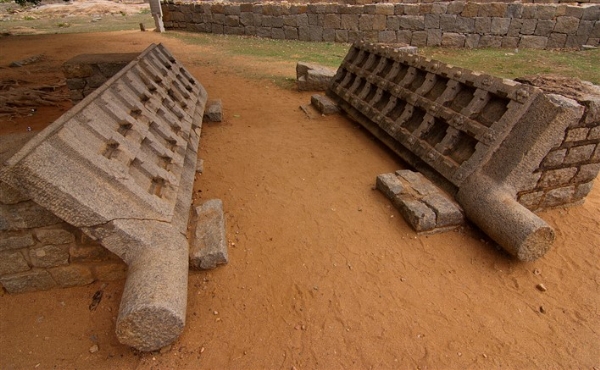
This is situated between the northwest corner of the Royal Enclosure and the mud track that goes around it. The remarkable stone doors are believed to be a part of the imposing fortification of the enclosed area during the period of the Vijayanagara Empire. The exquisitely carved stone doors display the skill of the craftsmen of the Vijayanagara era. Each stone door was sculpted out of a single huge boulder. The doors have door bolts and pivot shafts attached to them even today.
6. Mahanavami Dibba :
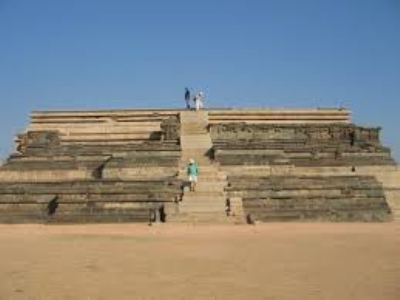
The whole structure is made as a giant square structure in three layers. This is the tallest structure in this area and hence the first thing you would notice as you enter the Royal Enclosure. From a distance this looks like an ordinary elevated square stage. As you go close, the details emerge. The whole structure is made as a giant square structure in three layers.
There are mainly two stairways to reach the top. The front one (east facing) is highly decorated on either sides with carvings of elephants, horses and a host of other things. On the top there is nothing special to see except the great views on the campus around it.
7. Zenana Enclosure :
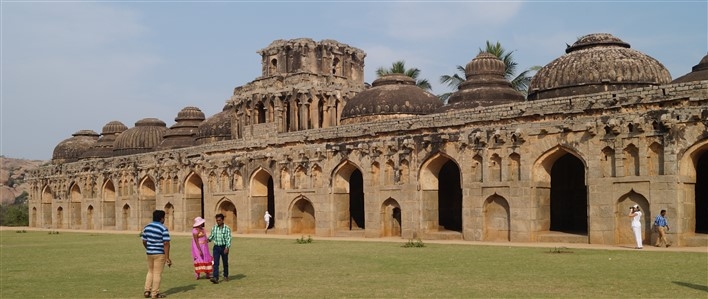
Zenana enclosure was a secluded area reserved for the royal women. The whole area was the private enclosure for the royal women folks. The Queen’s Palace (visible only the basement) is located at the middle of this area, on the left side of your path. Measuring about 46 x 29 meters, this has been the largest palace base excavated in the Hampi ruins so far. Also the three-tiered elaborate base structure speaks of its importance as a palace. The super structure was made of wooden or less durable materials compared to the stone base. Along with the other royal structures, a gut during the rival incursion could have destroyed the palace. A rectangular deep tank (now empty) just at east of this probably used as a water source to the palace.
8. Palace of Vira Harihara
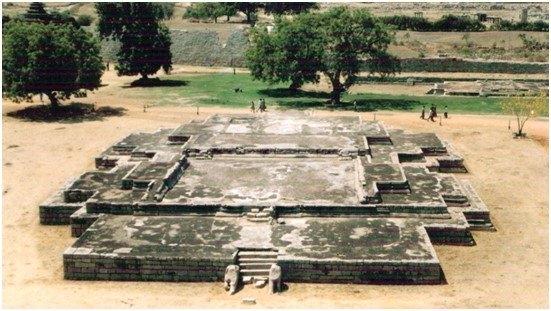
Like many other palatial structures in Hampi, all what you can see here is the ground level remains of the palace and associated structures. The base of this palace, along with a number of other residential artefacts, is located inside a compound that is at south of Hazara Rama Temple. The beauty and architecture of the Palace of Vira Harihara can only be imagined. The ornate base of the palace provides an idea about the architecture of the long lost structure. Moreover, the rich architectural beauty of the other structures of Hampi indicates that the palace of Vira Harihara must have been a magnificent one in terms of construction and splendour.
There is no trace of the palace walls. Though not much is known about the superstructure of the palace, it is believed that the palace architecture made extensive use of wood and other perishable materials.
Follow this series of architectural cities to get to know more about its wonderful architecture and listen to its story with a little more interest.
- Vaishnavi Sarwate
